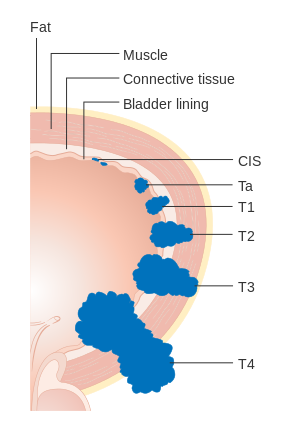TNM Staging System: Difference between revisions
(Created page with " == Introduction == Staging a tumor is the process of finding out the cancer in a patient. A cancer’s stage can also be used to help predict the course of the cancer, as wel...") |
No edit summary |
||
| Line 30: | Line 30: | ||
The TNM staging system could also be used for an autopsy re-examination of the cancer. In that cases is defined as aTNM. | The TNM staging system could also be used for an autopsy re-examination of the cancer. In that cases is defined as aTNM. | ||
== References == | |||
Revision as of 14:10, 27 April 2022
Introduction[edit | edit source]
Staging a tumor is the process of finding out the cancer in a patient. A cancer’s stage can also be used to help predict the course of the cancer, as well as how likely it is that treatment will be successful. It is used in almost every oncological patient to describe the tumor, regardless of the localisation of the primary cancer.
In most cases the biopsy exam do not modified the TNM stage system: infact the biopsy finds out if a disease is present and, if so, it precisely and accurately classifies the disease according to the cells differentiation. TNM system could stage both benign or malign tumors. Infact in case of benign tumors, the N and M letters would be follow by 0.
In the TNM system, the overall stage is determined after the cancer is assigned a letter or number to describe the tumor (T), node (N), and metastasis (M) categories[1].
T: Tumor Size[edit | edit source]
T describes the original (primary) tumor. The T determine the size of the tumor according to the physical assessment or imaging and endoscopy exams.
- TX means there’s no information about the primary tumor, or it can’t be measured.
- T0 means there is no evidence of a primary tumor (it cannot be found).
- Tis means that the cancer cells are only growing in the layer of cells where they started, without growing into deeper layers. This may also be called in situ cancer or pre-cancer.
- T1-T4 describe the size and/or the extension of the tumor. The higher the T number, the larger the tumor and/or the more it has grown into nearby tissues.
N: Lymph Nodes[edit | edit source]
N describes the degree of spread to regional lymph nodes.
TNM reassessment[edit | edit source]
The cancer stage is also a way for doctors to describe the extent of the cancer and the aggravation during time. When a cancer is staged again after the initial staging, it is sometimes referred to as restaging. Infact the first clinical stage (cTNM) is often reassessed by the surgeon during surgery. Because of that the new reassessement is called the pathological stage (pTNM).
Other reassessment of the TNM staging are made in case of radiotherapy or chemotherapy. In case of adjuvant therapy the ycTNM defines the stage after the radiotherapy or chemotherapy but before surgery. If the patient underwent surgery after the adjuvant therapy, the TNM stadiation is referred to ypTNM.
In case of secondary tumors or relapsed cancers the staging is added to the previous primary classification. It is defined as rTNM when its stadiation is only clinical, or rpTNM when the new stadiation had a pathological examination.
The TNM staging system could also be used for an autopsy re-examination of the cancer. In that cases is defined as aTNM.
References[edit | edit source]
- ↑ American Cancer Society. Overview: Testicular Cancer, What is Testicular Cancer? American Cancer Society, Inc.; 2009-08-28; 2010-02. Available from: http://www.cancer.org/docroot/CRI/content/CRI_2_2_1x_What_Is_Testicular_Cancer_41.asp?sitearea=







